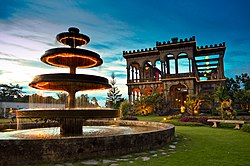Talisay, Negros Occidental
| Talisay | ||
|---|---|---|
| Component City | ||
| City of Talisay | ||

View of The Ruins of the Mariano Ledesma Lacson Mansion, Talisay City at dusk
|
||
|
||
 Map of Negros Occidental showing the location of Talisay City |
||
| Location within the Philippines | ||
| Coordinates: 10°44′N 122°58′E / 10.733°N 122.967°ECoordinates: 10°44′N 122°58′E / 10.733°N 122.967°E | ||
| Country |
|
|
| Region | Negros Island Region (NIR/Region XVIII) | |
| Province | Negros Occidental | |
| Congr. district | 3rd district of Negros Occidental | |
| Founded | 1788 | |
| Incorporated (town) | September 29, 1850 | |
| Incorporated (city) | February 11, 1998 | |
| Barangays | 27 | |
| Government | ||
| • Mayor | Nilo Jesus Antonio Neil E. Lizares III | |
| • Vice Mayor | Samuel M. Siote | |
| Area | ||
| • Total | 201.18 km2 (77.68 sq mi) | |
| Population (2015) | ||
| • Total | 102,214 | |
| • Density | 510/km2 (1,300/sq mi) | |
| Time zone | PHT (UTC+8) | |
| ZIP code | 6115 | |
| Dialing code | 34 | |
| Income class | 4th class city; partially urban | |
| Website | www |
|
Talisay, officially the City of Talisay and often referred to as Talisay City, is a fourth class city in the province of Negros Occidental, Philippines. According to the 2010 census, it has a total population of 97,571 people. It is part of the metropolitan area called Metro Bacolod, which includes its neighbors Silay to the north and Bacolod to the south. It has a total land area of 20,118 hectares (49,710 acres).
The Negritos, natives who led nomadic lives at the foot of scenic North Negros mountain ranges, originally inhabited Talisay. In 1788, families of Malay descent settled in the pristine part of Negros Island and named it Minuluan. Unknown to many, the sugar industry in province has its very roots in Talisay. The enterprising Recollect priest led by Fray Fernando Cuenca, spurred the economic development of this once sleepy Sitio through the planting of sugarcane in vast tracts of land we call ‘haciendas’.
The seedlings, brought from Spain, thrived well in the rich, loamy soil. Fray Cuenca improved sugar production of the crude wooden mills with the invention of ‘Molino de Agua’. The Spanish colonizers became guardians of our economic, socio-political and spiritual lives, and with more of the Minuluan population embracing the Catholic faith, the Sitio was decreed a town on September 20, 1850, with San Nicolas de Tolentino as its patron saint. It was renamed Talisay after the tree that grew in abundance along the mouth of the Matab-ang River.
To accommodate the growing population, three more barrios were established – Dos Hermanas and San Fernando in the northern part and Concepcion in the South.
At the turn of the century, Talisay became a significant player in revolt against Spain through the leadership of General Aniceto Lacson. The wily general and erstwhile Katipunero of the North teamed up with General Araneta from the South during the victorious Cinco de Noviembre uprising in 1898 that saw the Spaniards capitulating without bloodshed. The intervening years saw Talisay growing and methamorphosing into the budding city that is today-full of promise and potential. On February 11, 1998, Talisay through the effort of its local official led by the Mayor Amelo Lizares was finally elevated into a city.
Talisay is also known for its 2 major tertiary institutions: The Technological University of the Philippines – Visayas and Carlos Hilado Memorial State College, Main Campus.
...
Wikipedia


